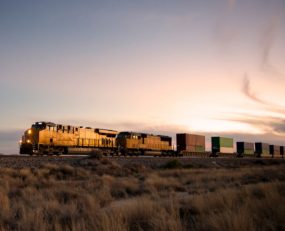
J.B. Hunt and CSX quarterly numbers just released present interesting comparisons in the US road and rail freight market.
J.B. Hunt Transport Services saw profits fall 1% in the first quarter, led by a fall in profitability at its core Intermodal business. Here “revenue per load” increased by 11% but volumes fell by 7% year-on-year. This was despite “persistent severe winter weather events” affecting its operations around Chicago in particular. However higher costs across the board, from lower utilisation to higher driver’s wages, resulted in operating profits falling by 10%.
CSX Corporation also saw falls in intermodal traffic in the first quarter, down 5% year-on-year. However, this was complicated by rationalisation by the railroad of “low density” routes. The company asserted that underlying demand for moving shipping containers to and from ports was strong. Admittedly other commodities, notably chemicals saw overall volumes increases on an annualised basis and this may well have underpinned the quarterly results that saw revenue edge up 5% but operating income and Earnings Before Tax jump 17%.
Generally underlying freight demand experienced by both CSX and J.B. Hunt was reasonable if not exciting. In the conference call on the quarterly numbers the management of J.B. Hunt expressed their slight disappointment that it was “still waiting for customer demand to accelerate”.
The underlying question is whether CSX ‘s aggressive market posture is simply able to work assets more aggressively than its competitors. Although for several years major customers have been complaining about CSX’s approach, these sorts of results suggest that ‘precision scheduled railroading’ is delivering the combination of performance – CSX is claiming that it is able to improve the reliability of its services, with it already having increase the proportion of on-time service from 70% to 75% – and price that enables CSX to gain both market share and work fixed assets more profitably. It states its ambition is to achieve a reliability level of 90% and if it can combine this with continuing cost control it would be in a stronger position in the North American freight transport market than any railroad has been in for many decades.
Source: Transport Intelligence, April 18, 2019
Author: Thomas Cullen